Woolstone: The Barge Inn - Sarah
Woolstone and The Barge Inn
Modern day Woolstone includes the villages of Little Woolstone and Great Woolstone.
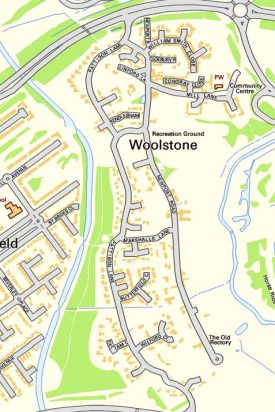
Map of modern day Woolstone. The River Ouzel runs along the eastern edge and the canal on the western edge of the village. From: OS Street View®, Scale 1:10000, Tiles: sp83ne, Updated: 1 April 2016, Ordnance Survey (GB), Using: EDINA Digimap Ordnance Survey Service.
The two villages were originally surrounded by fields used for both arable and pasture and both had a pub: The Barge Inn in Little Woolstone and The Cross Keys at Great Woolstone.
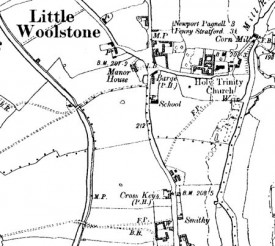
Map of Little Woolstone dating to 1900. The Barge Inn is located on the crossroads along Newport Road. (c) Crown Copyright and Landmark Information Group Limited (2016). All rights reserved. (1900).
The Woolstones retained their rural character even with the arrival of the Grand Junction Canal in the 19th century. Narrow boats filled with coal made their way along the newly constructed Grand Junction Canal to London. The canal passes along the western edge of the Woolstones with three bridges (Nos. 83, 84, and 85) providing access to and from the villages.
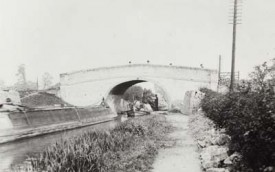
Photograph of narrowboats at bridge 84 at Woolstone on the Grand Junction Canal in 1910. The photograph shows the boat ‘Two Sisters’ and some people are standing on the bridge. From: Canals and River Trust, Waterways Archive BW192/3/2/2/12/1/256
Whilst the coming of the Grand Junction Canal brought limited change to the villages, the local pubs provided a welcome stopping point for those using the waterways. Bridge No. 83 led directly to The Barge Inn, which sits on the corner of the main crossroads of the village.
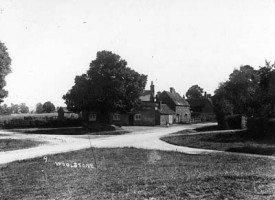
The Barge Inn in 1910 from the crossroads. From: Bucks County Museum’s Collections (Ref: phWoolstone cum Willen52)
Certainly a number of barge workers frequented the Barge Inn although it is not certain if the pub was built specifically to cater for this ‘passing’ trade. However, architectural features such as the doorcase suggest it dates to some time after 1800 (Giggins n.d).
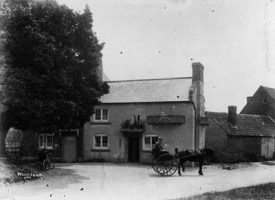
Man with a horse-drawn trap outside The Barge Inn in 1910. From: Bucks County Museum’s Collections (Ref: phWoolstone cum Willen48)
Living and working at The Barge Inn
The census records provided information on those that lived and worked at The Barge Inn. In 1871 Thomas Cox is listed as the Publican.
By 1881 Thomas Cox (now aged 63 years) was married to Susan Cox (aged 47 years). Thomas Cox is listed as a Licensed Victualler in the census.
The census entry for 1891 lists Susan Cox as the Innkeeper. She was widowed by this time. By 1901 Jesse Fleet was the Innkeeper (aged 61 year) along with his wife Mary (aged 60 year). Their two sons also lived there: Harry Fleet (aged 23 years) who was a horse keeper on farm in the village; and Jesse Fleet (aged 20 years) who was a shepherd.
Samuel Savage is listed as the Publican for The Barge Inn in 1911. The building was said to be haunted by Samuel Savage who died in 1933 (Giggins n.d).
The 1911 census entry for The Barge Inn. Samuel Savage is listed alongside his wife Annie. From: Ancestry.co.uk
It was in The Barge Inn that local villager, Alf West, regularly demonstrated his unusual talent – strong teeth! Just to the right of the entrance was the tap room which contained a hearth. This hearth was made from part of a train engine wheel. It is said that, “Alf would tie a rope around the wheel, clench the other end of the rope in his teeth and lift it off the ground” (Giggins n.d). Apparently he used this same act of strength to remove a body from the local mill pond (Giggins n.d).
References
Giggins, B. n.d. Full Steam Ahead! In Milton Keynes Parish Survey: Little Woolstone. 1993. Milton Keynes Archaeology Unit.

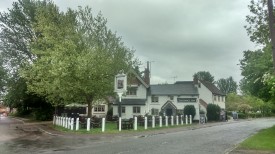




Comments about this page
Surely in late sixties the barge made its own wines eg parsley the recipes for which were later sold to a large Corp co eg Merrydown ?
Add a comment about this page